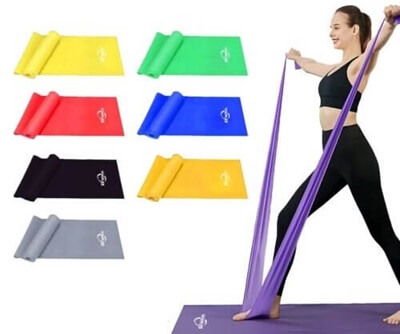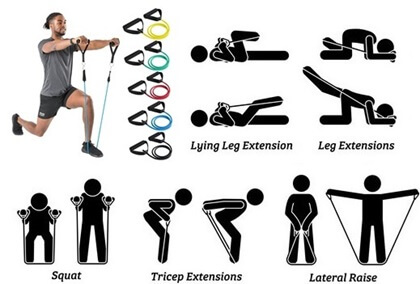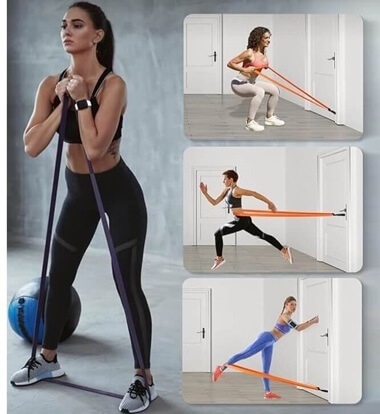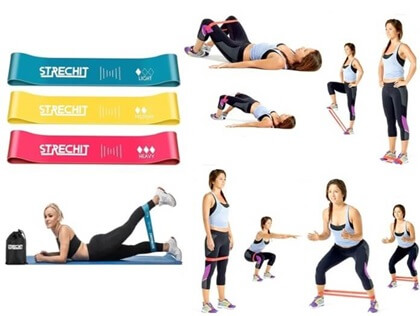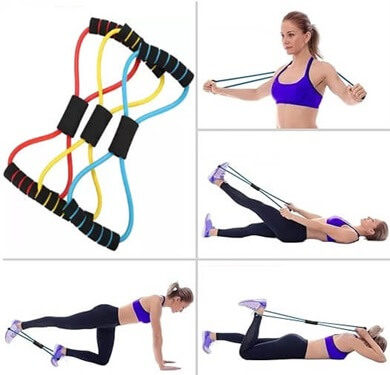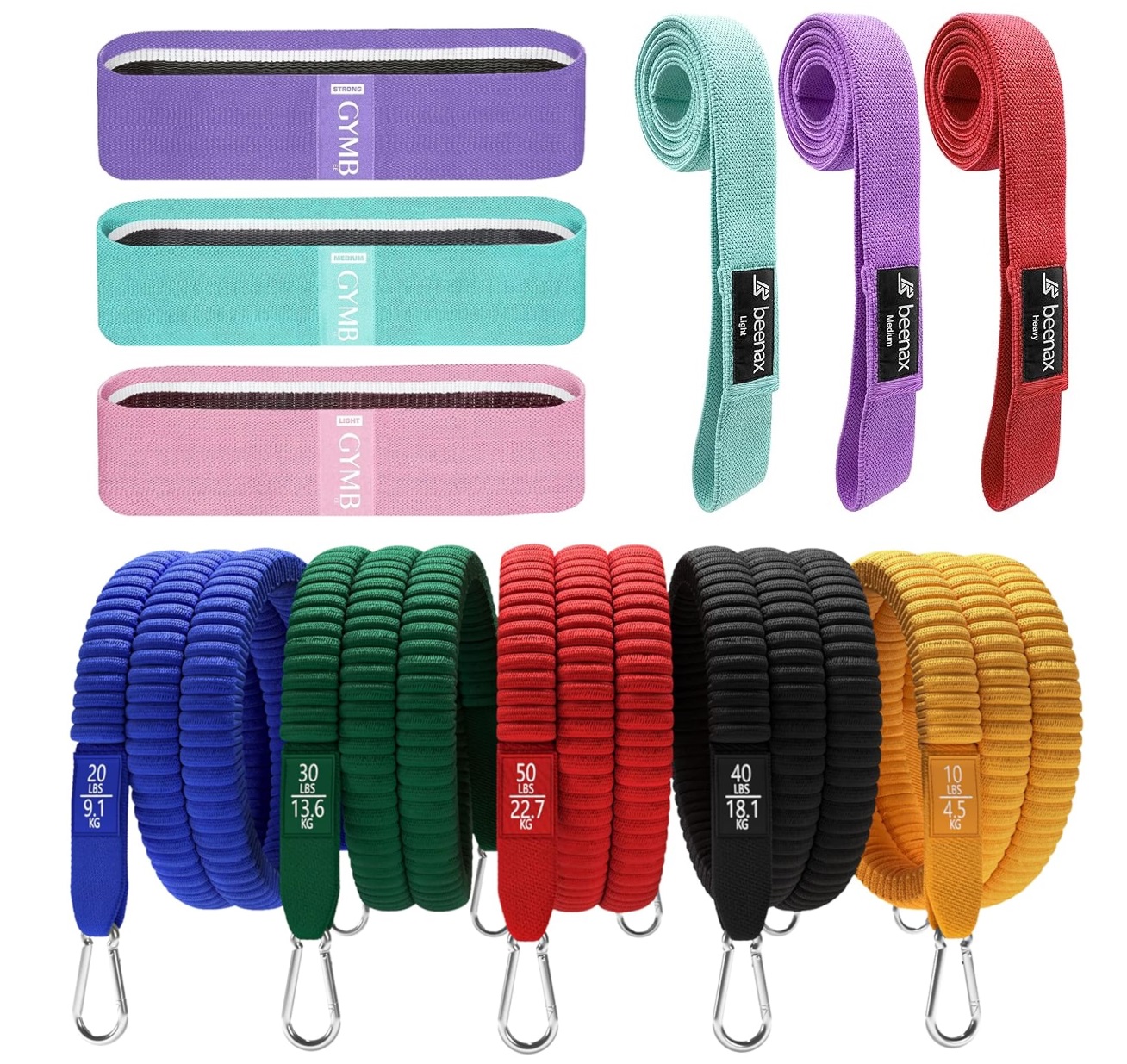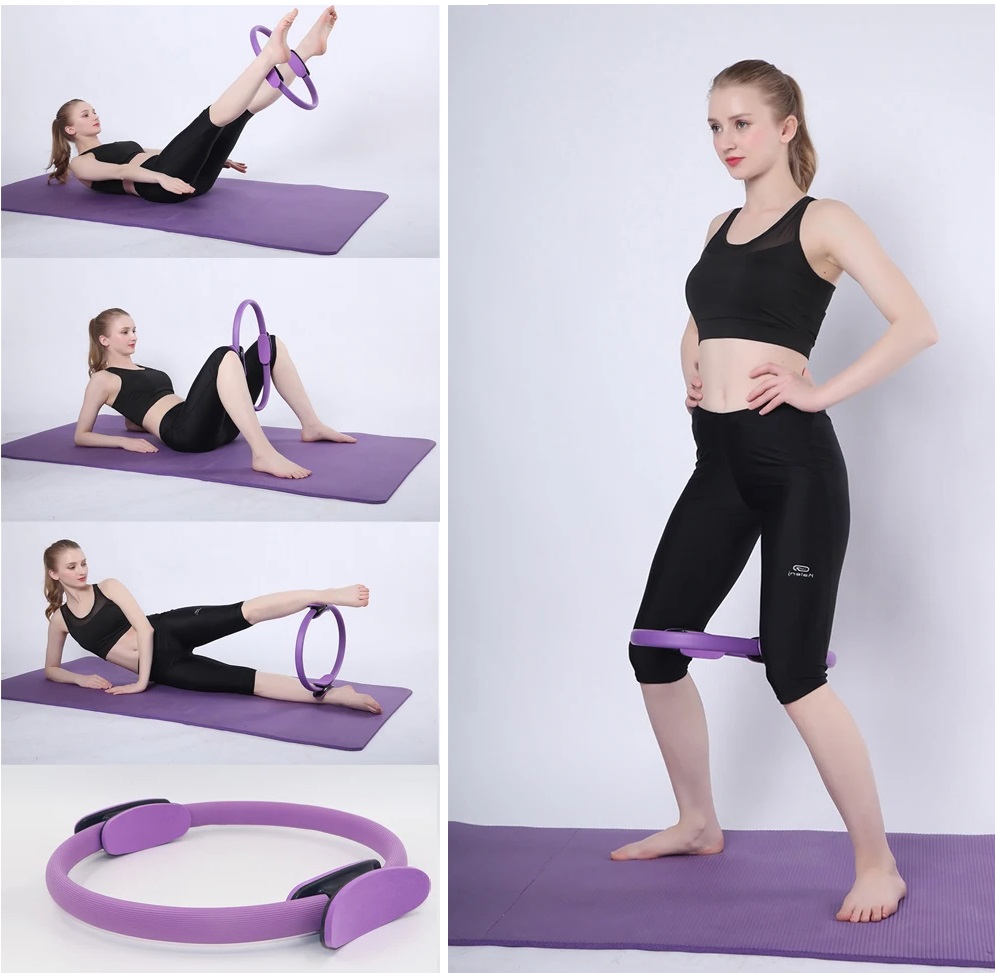- Home
- Knee Pain Treatment
- Resistance Band Types
Types Of Resistance Bands
Written By: Chloe Wilson, BSc(Hons) Physiotherapy
Reviewed by: KPE Medical Review Board
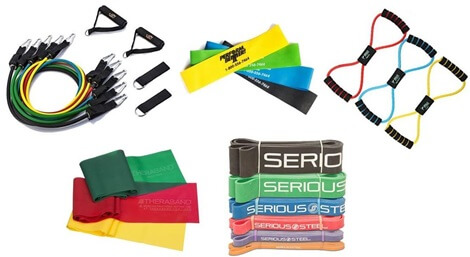
There are lots of different types of resistance bands to choose from and it can be hard to know where to start.
Resistance bands are a great tool for exercising and are extremely versatile.
They help you to build muscle strength by putting your muscles under tension as they work. The further you stretch the band, the harder your muscles work!
There are a whole range of types of resistances bands including loops, tubes, figure of 8s and power bands all of which are available in different strengths.
Suitable for almost anyone, from beginners to elite athletes, and young to old, resistance bands are an excellent exercise tool.
Here we will look at what resistance bands are, how they work, the different types of resistance bands and how to choose the right one for you.
What Are Resistance Bands?
Resistance bands are flexible, elastic tools designed to add resistance to your workouts, providing a challenging alternative to traditional free weights or weight machines.
Typically made from latex or latex-free materials, resistance bands come in various shapes, including flat, tubular, looped, and figure-eight designs.
By creating tension during movements, resistance bands engage muscles effectively, promoting muscle growth and enhancing overall fitness. As you pull against a resistance band, the tension in the band gradually increases. The further you pull, the harder your muscles have to work to keep stretching the band.
Whether you're a fitness enthusiast, a beginner, or someone undergoing rehabilitation, incorporating one or more type of resistance band into your routine can add a dynamic element to your exercise regimen. They offer a portable and versatile solution for strength training, rehabilitation, and flexibility exercises.
What Do Resistance Bands Do?
Resistance bands are versatile fitness tools designed to add resistance to your workouts, contributing to enhanced strength, flexibility, and overall fitness. Whichever types of resistance bands you use, they help with:
- Muscle Engagement: When you use resistance bands, your muscles have to work against the tension provided by the band. This engagement activates and strengthens various muscle groups, depending on the type of exercise performed.
- Adaptable for Different Fitness Levels: Resistance bands come in various tension levels, from light to heavy. This makes them suitable for individuals of different fitness levels, allowing for progression as strength increases.
- Strength Training: Resistance bands are effective for strength training exercises. They create resistance during both the concentric (muscle shortening) and eccentric (muscle lengthening) phases of movement, promoting muscle development.
- Stability Training: Resistance bands keep constant tension through muscles as they are working. Bands typically require more balance and co-ordination that weights which helps improve stability.
- Versatility: The different strengths and types of resistance bands offer a wide range of exercises for different muscle groups. Whether you're targeting your arms, legs, back, or core, resistance bands provide a versatile solution for a full-body workout.
- Portability and Convenience: One of the significant advantages of resistance bands, particularly over weights, is their portability. They are lightweight and easy to carry, making them ideal for home workouts, travel, or for those who prefer exercising outdoors. It also doesn’t hurt if you drop them on your foot!
- Rehabilitation and Injury Prevention: Resistance bands are commonly used in rehabilitation programs. Their adjustable resistance levels and ability to provide controlled movements make them suitable for individuals recovering from injuries or surgery. Resistance bands can even be used to make exercises easier, by supporting joints.
- Improved Range of Motion: Incorporating resistance bands into your routine can help improve flexibility and joint mobility. The bands allow you to stretch and move your muscles through a full range of motion, promoting better overall flexibility.
- Cost-Effective Fitness Tool: Compared to traditional gym equipment, resistance bands are more affordable. They provide a cost-effective way to add resistance to your workouts without the need for bulky machines or heavy weights.
Find out more about the benefits of resistance bands and how to use them.
What Types of Resistance Bands?
There are lots of different types of resistance bands on the market, varying in shape, style, material and strength. Let's have a look at the eight most commonly used types of resistance bands, what they can be used for and how they differ.
1. Standard Therapy Band
The original long resistance bands, standard therapy bands are long, wide, flat, thin pieces of rubber.
They are extremely versatile and can be used in a variety of ways by choosing what length you want.
These long resistance bands are very simple to use and can be tied to create loops of any size or anchored to furniture/doors.
On Sale: $10/£10/€14 (Amazon)
2. Tube Resistance Band
Tube resistance bands are long tubular bands which have handles or loops on either end, aka fit tube resistance bands.
The handles make great anchors that you can either grip in your hands or hook onto your feet or elbows depending on what exercises you are doing.
On Sale: $22/£14/€18 (Amazon)
3. Loop Resistance Band
Loop resistance bands are also known as power resistance bands. These are essentially like large, wide elastic bands.
They are similar to standard therapy bands but are looped round to form a long, continuous loop. This can make them easier to anchor to things and means you don't need to worry about tying and untying knots.
Loop resistance bands often come with an anchor set to make it even easier to attach to doors for increased versatility.
On Sale: $20/£15/€18 (Amazon)
4. Mini Resistance Bands
Mini resistance bands are a smaller version of a loop band, aka fit loop bands, hip circle bands or booty bands.
Mini resistance bands are perfect for exercises where you want to hook them around your ankles, knees, thighs or arms to do small movements.
The resistance kicks in really quickly because of their short length.
On Sale: $10/£10/€10 (Amazon)
5. Figure 8 Bands
Figure 8 bands are short tube bands with handles on either end. They are fixed in the middle to form a figure of 8 shape.
Figure 8 bands are particularly good for arm/shoulder exercises but can also be used for leg exercises too.
They are similar to mini resistance bands but their tubular shape can be more comfortable. You can even attach handles to them to anchor them to furniture.
On Sale: $10/£8/€12 (Amazon)
6. Running Resistance Bands
Running resistance bands, aka speed bands, come with straps that you attach around your thighs, ankles or waist and clip the resistance bands to.
The straps stay firmly in place so the resistance bands are anchored securely meaning they are less likely to slip.
Running resistance bands are perfect training tools for runners looking to improve their speed and strength.
On Sale: $30/£25/€30 (Amazon)
7. Fabric Resistance Bands
While most resistance bands are made from latex, synthetic rubber or silicon, fabric resistance bands are made out of fabric material, typically a cotton and polyester mix.
People often find them more comfortable as they are less likely to slip on your skin, and they are also less likely to break under tension.
However, fabric resistance bands are more expensive than traditional resistance bands.
On Sale: $18/£10/€14 (Amazon)
8. Ring Resistance Bands
Ring resistance bands, aka Magic Circle or Pilates Ring, are circular shaped pieces of resistance equipment. They have padded edges that can be held between your hands, arms, thighs, knees or ankles to target specific areas.
They have more structure to them than traditional bands, but apply resistance in a similar way.
I love these and use them a lot when teaching Pilates. You push them inwards for resistance, or pull outwards from the inside of the ring to engage core muscles when exercising.
On Sale: $20/£13/€14 (Amazon)
Different types of resistance bands are suited for different exercises. For example, if you are looking to do small movements, loop resistance bands or figure 8 bands may be perfect, whereas if you are wanting to do big arc movements, tube or standard therapy bands tend to be best.
Resistance Band Color Coding
As well as there being lots of variety in the types of resistance bands, they are also available in a range of strengths. Resistance band color coding is linked to the stretchability of the band – the harder it is to stretch the band, the more resistance is applied to your muscles and the harder they have to work. The bands typically get slightly thicker as the resistance increases.
There are loads of different brands of resistance bands on the market nowadays and unfortunately, they don’t all use exactly the same color coding, but most brands use the following resistance band color chart pattern:
- Light Resistance Band: Yellow (extra light), red (light)
- Medium Resistance Band: Green (light-medium), blue (medium)
- Heavy Duty Resistance Band: Black (medium – heavy), Silver (heavy), Gold (heaviest)
Resistance Band Colors Chart
It can be hard to know exactly how much resistance each band offers. One of the most well-known brands of resistance band is Theraband.
With theraband resistance bands, the resistance (pull force) increase 25% with each color progression, whatever types of resistance band you are using.

A good resistance band colors chart will make it clear how much resistance the band offers at different levels of elongation i.e. how much you stretch it.
Resistance ranges for theraband are as follows:
- Yellow Resistance Band: 1.8 - 4.3lbs or 0.8 - 2kg
- Red Resistance Band: 2.6 - 5.5 lbs or 1.2 - 2.5kg
- Green Resistance Band: 3.2 - 6.7 lbs or 1.5 - 3kg
- Blue Resistance Band: 4.6 - 8.6lbs or 2.1 - 3.9kg
- Black Resistance Band: 6.3 - 10.2 lbs or 2.9 - 4.6kg
- Silver Resistance Band: 8.5 - 15.3 lbs or 3.9 - 6.9kg
- Gold Resistance Band: 13.9 - 21.3 lbs or 6.3 - 9.7kg
#CommissionsEarned from Amazon on qualifying purchases
Resistance bands are often available in sets so you can try out different colors/resistance levels. And if you are looking to work more than one muscle group, then you may well want a range of colors and types of resistance bands.
How Do You Use Resistance Bands?
Using resistance bands is a straightforward yet effective way to enhance your workout routine. Here's a brief guide on how to use resistance bands:
- Choose the Right Band: Start by selecting a resistance band with an appropriate level of tension for your fitness level and the specific exercise you plan to perform. Bands are color-coded to indicate different resistance levels as explained above. Choosing the right color band for you will depend on things such as what muscles you are working, your fitness level and strength and how much you are looking to challenge yourself.
- Secure the Band: For exercises that involve anchoring the band, ensure it is securely fastened. You can loop it around a sturdy anchor point, such as a door handle or a pole, or use specialized door attachments that come with some bands. IF you are using loop bands, you simply wrap them around the joints you are targeting.
- Understand Grip and Form: Pay attention to your grip and form. Whether you're holding the band with your hands or securing it around your ankles, maintain proper posture and alignment to maximize the effectiveness of the resistance and make sure you are exercising safely.
- Controlled Movements: Engage in controlled movements throughout the exercise. The resistance provided by the band should be challenging but manageable. Focus on both the concentric (contracting) and eccentric (lengthening) phases of each movement. It is actually harder work to control the movement as you relax the muscle so make sure you lower down slowly, rather than letting the band pull you down.
- Variety of Exercises: Resistance bands are incredibly versatile. You can use them for various exercises targeting different muscle groups, including squats, bicep curls, shoulder presses, leg lifts, and more. Explore online resources or consult with a fitness professional to discover a wide range of exercises.
- Progress Gradually: As your strength and endurance improve, you can progress to bands with higher resistance levels rather than finding new exercises to do or having to increase the number of repetitions. This gradual progression ensures that your muscles continue to be challenged and strengthened over time.
- Endurance v Strength: if you are looking to increase muscle strength, you want to choose a heavier resistance but will do a lower number of repetitions. If you are looking to improve muscle endurance (how long a muscle can work for before it gets tired), you want to choose a lighter resistance but do more repetitions - this is particularly good for stability muscles.
Incorporating resistance bands into your workout routine offers the advantage of increased resistance throughout the entire range of motion, promoting muscle engagement and growth.
You may be interested in the following articles:
Summary
There are lots of different types of resistance bands to choose from that you can incorporate into your exercise plan.
Resistance bands are extremely versatile, cheap and easy to use and are highly effective at improving muscle strength, endurance, fitness and stability.
The main types of resistance bands are standard therapy bands, tube resistance bands, loop resistance bands, mini loop bands, figure 8 bands, running resistance bands and ring resistance bands.
You can work pretty much any muscle group with resistance bands, targeting both power muscles and core muscles at the same time.
Resistance band color coding varies between manufacturer but typically goes from light resistance to max resistance in the following color order – yellow, red, green, blue, black, silver, gold. It is always worth checking the resistance band color chart for whichever type of resistance band you are using
You can find all the different colors and types of resistance bands on Amazon.
You may be interested in the following articles:
- Benefits Of Resistance Bands
- Resistance Bands Vs Weights: Pros and Cons
- Leg Stretches
- Knee Strengthening Exercises
- Knee Treatment Guide
- Knee Pain Diagnosis Chart
Page Last Updated: 22/05/24
Next Review Due: 22/05/26
